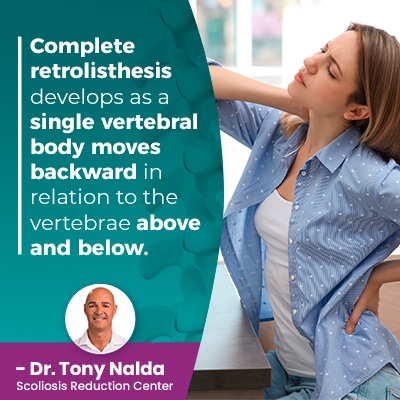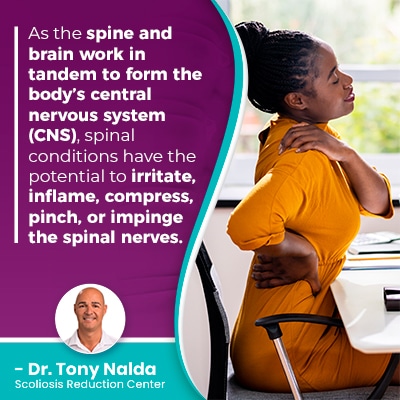Retrolisthesis: Types, Causes, Symptoms, & Treatment Options

In order for the spine to function optimally, the health of its individual structures needs to be maintained. If a vertebra shifts out of position, it can affect the spine in a number of ways, as the spine is no longer aligned. In cases of retrolisthesis, a vertebra shifts backward alongside a spinal disc and can shift underneath the disc.
Retrolisthesis is a type of uncommon joint dysfunction in the spine that involves a single vertebral body shifting backward, alongside a spinal disc, or underneath it. The condition affects the cervical and lumbar sections of the spine, can cause a range of symptoms and needs to be treated proactively.
Before getting to the specifics of retrolithesis, let’s first explore some basic spinal anatomy.
Anatomy of the Spine
The spine is naturally curved in each of its sections, making it appear straight when viewed from the front or back and giving it a soft ‘S’ shape when viewed from the sides.
The spine’s natural and healthy curves make it stronger, more flexible, and better able to absorb/distribute mechanical stress incurred during movement along the spine evenly.
The spine has three main sections: cervical spine(neck), thoracic spine (middle/upper back), and lumbar spine (lower back).
The health of each of the spine’s natural curves is dependent upon the health of the others. In many cases, when a healthy curve is lost, the spine responds by putting in compensatory curves, which is why the biomechanics of the entire spine can be affected.
The spine is made up of vertebrae (bones) that are stacked on top of one another in a straight and neutral alignment, and this allows the spine to perform as it should, with its individual structures working together to maintain those natural spinal curves and keep the spine aligned.
In between adjacent vertebral bodies, there is what’s called an intervertebral disc; the discs of the spine are often the first spinal structures to show the effects of degeneration. This is partly because of the many important roles they play in spinal health and function.
The intervertebral discs consist of two main parts: an inner gel-like nucleus surrounded by a tough outer annulus.
The intervertebral discs help keep the spine flexible, provide cushioning between adjacent vertebrae to prevent friction during movement, and act as the spine’s shock absorbers.
In addition, discs provide the spine with structure as the vertebrae on either side of a disc attach to it, so with that in mind, you can see how a disc moves and how it can affect the positioning of adjacent vertebrae.
There are a number of disc issues that can develop as a result of disc degeneration: desiccation, bulging, or disc herniation (including lumbar disc herniation).
Retrolisthesis, characterized by the backward displacement of one vertebra in relation to another, can range in severity, with a 3 mm or 4 mm retrolisthesis indicating varying degrees of displacement. Grade 1 retrolisthesis at L5-S1 may be associated with degenerative disc disease, and treatment options should be considered based on the specific condition, such as retrolisthesis at C5-C6 or a trace retrolisthesis of L5 on S1, to address symptoms and provide appropriate care.
So any type of change in the spine is likely to affect its discs, and retrolisthesis is no exception.
What is Retrolisthesis?
How serious is retrolisthesis? There are many spinal conditions that can affect its structure, function, and overall health; retrolisthesis is an uncommon type of joint dysfunction that involves a single vertebral body shifting backward, alongside, or underneath an intervertebral disc.
Retrolisthesis is most commonly found in the cervical, and lower lumbar spine sections and rarely affects the thoracic spine.
(Note: Retrolisthesis is the opposite of degenerative spondylolisthesis. Both involve the slipping of the vertebral body, but the direction is the difference.)
You might be wondering how a slight shift of one vertebra can affect the spine, but the level of movement can be minor and still affect the spine negatively; in fact, even with as little vertebral movement as 2 millimeters, the spine’s alignment and biomechanics are disrupted.
Retrolisthesis, a condition involving the reversal of cervical lordosis, is known for its various types, causes, symptoms, and treatment options.
When it comes to the majority of spinal injury conditions, there are multiple types, each with its own causation and treatment needs, including mild retrolisthesis.
Types of Retrolisthesis
There are three main types of retrolisthesis: complete, partial, and staircase.
 Complete retrolisthesis develops as a single vertebral body moves backward between the spinal segment in relation to the vertebrae above and below.
Complete retrolisthesis develops as a single vertebral body moves backward between the spinal segment in relation to the vertebrae above and below.
Partial retrolisthesis occurs as a single vertebra moves backward and towards the vertebra above or below it.
Staircase retrolisthesis involves a single vertebra moving backward and away from the vertebrae above and below.
In some instances, a vertebra’s shift in position can cause a posterior shift back and underneath an intervertebral disc.
While these different condition types seem similar, the subtle distinctions of where and how a vertebra moves are important, and all can disrupt the alignment of the entire spine; this can affect the spine’s structural integrity, making it more prone to injury, and cause functional deficits.
Retrolisthesis can lead to the reversal of cervical lordosis, presenting with specific types, causes, symptoms, and requiring tailored treatment options.
Now that we have explored some basic spinal anatomy, defined retrolisthesis, and its different types, let’s talk about symptoms.
Symptoms of Retrolisthesis
Not only do most spinal conditions have multiple types, they also tend to range widely from moderate to severe, making symptoms vary from patient to patient.
Common symptoms of retrolisthesis can include:
- General back pain
- Localized back pain
- Decreased range of motion
- A noticeable bulge in the spine
- Sharp pinching pains due to nerve compression
How serious is retrolisthesis? As retrolisthesis can range in severity, additional symptoms are associated with more severe forms, which are largely determined by the degree of nerve involvement.
Sensations of numbness or tingling can be felt throughout the body:
- Neck
- Arms
- Legs
- Hips
- Thighs
- Buttocks
 As the spine and brain work in tandem to form the body’s central nervous system (CNS), spinal conditions have the potential to irritate, inflame, compress, pinch, or impinge the spinal nerves.
As the spine and brain work in tandem to form the body’s central nervous system (CNS), spinal conditions have the potential to irritate, inflame, compress, pinch, or impinge the spinal nerves.
As nerves are like branches of a tree, fanning off in different directions, when a nerve is exposed to uneven pressure, its effects can be felt anywhere along the nerve’s pathway, which can be extensive.
The spinal canal is a hollow space inside each vertebra through which the spinal nerves pass, and retrolisthesis can cause the spinal canal to lose space, becoming narrower and putting pressure on the nerves within.
As a vertebral body shifts backward, as well as causing nerve compression, it can also put added stress on the disc: another way the condition can disrupt spinal alignment and function.
Retrolisthesis, particularly grade 1 degenerative retrolisthesis, such as retrolisthesis of L2 on L3, is a condition affecting spinal stability and associated with degenerative lumbar spine and other degenerative spinal disorders. Understanding its types, causes, and symptoms is crucial for exploring effective retrolisthesis grade 1 treatment options.
Retrolisthesis, often associated with conditions like levoconvex scoliosis and multilevel degenerative disc disease, often requires treatment to manage the condition.
So, now that we know the types of symptoms associated with retrolisthesis, let’s talk about treatment options.
Retrolisthesis Treatment Options
Can retrolisthesis be reversed? For people recently diagnosed with retrolisthesis, there are a number of treatment options, and treatment plans should be customized around key patient/condition variables: patient age and overall health, causation, severity, experienced symptoms, and how the area around the slippage is affected.
Here at the Scoliosis Reduction Center, I provide treatment for a variety of spinal injuries and conditions, retrolisthesis included, and I treat them non-surgically so patients can benefit from noninvasive, less-costly, and less-risky treatment.
While there are never treatment guarantees, under a conservative chiropractic-centered treatment approach, I combine multiple treatment disciplines and methods for the best potential results.
Physical therapy can help increase the strength of the back and core muscles, so the spine is optimally supported and stabilized, and condition-specific targeted exercises can help relieve pressure on the affected area of the spine and activate certain areas of the brain for improved brain-body communication and to further increase strength.
With condition-specific chiropractic care, gentle and precise manual adjustments, and techniques such as flexion-distraction therapy, stretching, and decompressing the spine can be worked towards.
Patients of the Center have access to our state-of-the-art equipment. For example, the use of a traction table can help decrease pressure and increase space within an affected disc, and this works by allowing the disc fluid to reclaim its central position inside the disc, which also increases the disc’s nutrient supply for optimal healing and restoration.
In addition, a wide variety of alternative treatments can help with improving circulation and pain management: massage, heat therapy, and microcurrent therapy for reducing swelling, inflammation, and pain.
Conclusion
The spine is an integral structure of human anatomy; not only does it allow us to stand upright, practice good posture, bend, twist, lift and move, it also gives the body structure and works with the brain to form the central nervous system.
As the spine is involved in virtually every system at work within the body, any condition that impacts its health and function can affect the body in a myriad of ways.
Retrolisthesis is a spinal condition that involves the degeneration of spinal discs due to the backward slippage of a vertebra, which exposes the disc and its surrounding area to uneven pressure and can cause the spine to become misaligned.
When a spine is misaligned, its biomechanics, function, and overall health are impacted negatively.
When a displaced vertebra encroaches on disc space, causing a narrowing of the spinal canal, it can disrupt nerve transmission of signals/messages from the brain, cause nerve compression, and related symptoms of pain, tingling, and a reduced range of motion and flexibility in the spine.
Retrolisthesis is not a common condition, but it needs to be treated proactively through a series of chiropractic adjustments, physical therapy, and custom-prescribed condition-specific exercises.
Treatment success involves improving the affected disc’s health, along with increasing core strength for optimal spinal support.
Here at the Center, I work closely and diligently with patients to craft customized treatment plans that offer the best potential results without facing the risks associated with spinal surgery.
Dr. Tony Nalda
DOCTOR OF CHIROPRACTIC
After receiving an undergraduate degree in psychology and his Doctorate of Chiropractic from Life University, Dr. Nalda settled in Celebration, Florida and proceeded to build one of Central Florida’s most successful chiropractic clinics.
His experience with patients suffering from scoliosis, and the confusion and frustration they faced, led him to seek a specialty in scoliosis care. In 2006 he completed his Intensive Care Certification from CLEAR Institute, a leading scoliosis educational and certification center.
About Dr. Tony Nalda
 Ready to explore scoliosis treatment? Contact Us Now
Ready to explore scoliosis treatment? Contact Us Now





